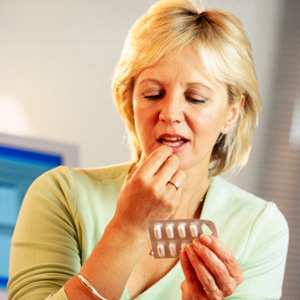All about hormone replacement therapy
Could HRT be the best way to manage your menopause symptoms? Find out more about the treatments, how they work and whether the risks outweigh the benefits... By Jane Murphy

What is HRT?
Hormone replacement therapy (HRT) is used to combat unpleasant symptoms of the menopause, such as hot flushes, night sweats, thinning bones, joint pain, mood swings, vaginal dryness and loss of libido.
Dr Hilary Jones, independent GP and chief medical adviser at online clinic Health Express explains: 'Menopause is a natural process, during which time the body's monthly ovulation process will stop and eggs will no longer be released. This occurs because of changes in the pituitary gland, which cause falling levels of oestrogen during the pre-menopause stage and then progesterone and testosterone at a later stage.
'HRT relieves menopause symptoms by replacing these hormones which the body no longer produces naturally. The primary purpose of HRT is to improve oestrogen levels, but it many also involve other hormones or compounds to compensate for lower progesterone and testosterone levels.'
Is it right for me?
Your GP will discuss with you whether HRT is the right treatment for you. But it helps to be armed with a list of key questions, so you can better appreciate what is happening to your body and then weigh up the options accordingly.
Dr Hilary advises: 'First and foremost, it's important that you gain a good understanding of the menopause process and how it will affect your body now and in the future. If you're considering treatment for symptomatic relief, it's wise to ask your doctor to give you a full explanation of how HRT works and whether it's definitely the right course of action for you. Your doctor will be able to talk you through the different HRT treatments available, the ways in which these can be taken and how long you'd be expected to stay on treatment.'
What are the main types?
In fact, there are 60 different preparations of HRT - but they broadly fall into three main categories.
Oestrogen-only HRT is usually recommended for women who have had a hysterectomy. There is no need to take progesterone as there is no risk of endometrial cancer.
Cyclical HRT - or sequential HRT - can be taken in one of two ways. Monthly HRT is recommended for women who are still having regular periods. It involves taking oestrogen every day, as well as progesterone for 14 days at the end of your cycle. Three-monthly HRT is more suitable for women who are experiencing irregular periods. It involves taking oestrogen every day, then progesterone for 14 days every 13 weeks. You should have a period every three months.
Continuous combined HRT is recommended for women who are post-menopausal - which means they haven't had a period for more than a year. It involves taking oestrogen and progesterone every day without a break.
How is it taken?
HRT can be taken several ways: a cream or gel, applied directly to the skin or vagina; tablets, taken orally or placed directly into the vagina to combat dryness; or a skin patch applied to the bottom of your back. Alternatively, you may opt to have an implant: small pellets of oestrogen are placed beneath the skin of your stomach, bottom or thigh - normally using local anaesthetic.
You will normally be prescribed a low dose to begin with, but this can gradually be increased if necessary.
What are the benefits?
As discussed previously, the main benefit of taking HRT is that it offers a reliable way to relieve common symptoms of the menopause. 'When taken for a few years, HRT has also been proven to help reduce risk of developing the bone-thinning disease osteoporosis, which is common in later life,' says Dr Hilary.
And what about the risks?
'Side effects of HRT can include nausea, weight gain and fluid retention,' warns Dr Hilary. 'And in some cases, periods may be re-introduced after they've stopped - although new preparations now work to combat this.
'HRT has also been at the heart of controversy, mainly because it has been linked to increases in the risk of developing certain types of cancer and strokes. However, these increased risks are also associated with natural ageing. That's why your doctor will ensure you are prescribed a treatment that's as safe as possible for you, and affords you adequate symptomatic relief, which will outweigh any potential health risks.'
It's also worth bearing in mind that the oestrogen used in HRT isn't as powerful as the oestrogen used in the contraceptive pill. So if you're still having periods, there's a chance you could still become pregnant. Use a non-hormonal method of contraception if you don't want this to happen.
What are the alternatives?
Aside from HRT, there are numerous ways you can attempt to combat menopause symptoms. These include various other forms of medication, as well as complementary therapies and lifestyle changes. Maintaining a healthy weight, eating a balanced diet, taking regular exercise, keeping alcohol consumption within safe limits, taking steps to tackle stress and quitting smoking will make a significant difference to your all-round health. Again, it's important to talk through all your options with your GP.
Where can I find out more?
For more information on HRT, contact the British Menopause Society.
You might also like...
Love your body through the menopause
What to eat for a better menopause
Sex after the menopause










